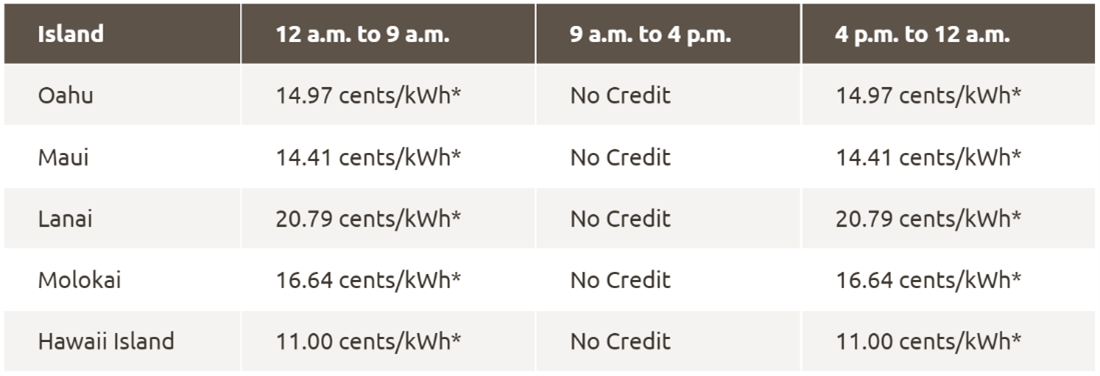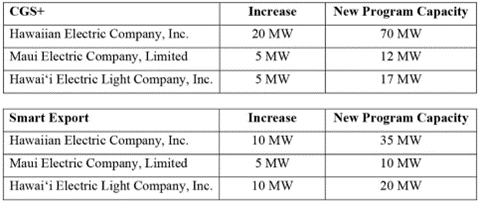Hawaii Solar and Storage Market Update (June 2022): Smart Export, CGS+, Battery Bonus
by Erin Christensen on Jun 27, 2022
battery bonus
Hawaii energy storage
hawaii solar
In 2015, Hawaii dissolved its net energy metering (NEM) program, resulting in the implementation of a wide range of distributed energy resource (DER) programs designed to increase grid stability, accelerate energy storage deployment, and support the statewide goal of achieving 100% renewable energy by 2045. At the end of last year, Hawaiian Electric (HECO), the utility serving most Hawaii residents, announced having over 1,000 megawatts (MW) of solar capacity integrated onto its grid. Although this grand milestone is worthy of celebration, HECO and the solar industry understand that Hawaii has a long road ahead to achieve the renewable energy targets set by the Hawaii Clean Energy Initiative.
The DER incentive programs currently available for enrollment include Customer Grid-Supply Plus (CGS+), Smart Export (SE), Battery Bonus, and NEM Plus (exclusive to those with existing NEM agreements). Below, we provide a brief description of each of the incentive programs available to new solar and storage customers, including any updates that recently went into effect.
Smart Export & CGS+
Launched in July 2018, the Smart Export and Customer Grid-Supply Plus programs were designed to encourage self-consumption and provide incentives for exported energy. These DER programs are the result of the immense interest seen with the first post-NEM DER incentive program, Customer-Grid Supply (CGS).
The SE program is designed for solar + storage systems up to 100 kW. It is expected that those enrolled in this program will have a solar PV system with the production capacity to charge an energy storage system (ESS) in addition to meeting the participant’s daytime electricity demands. A fixed export credit rate is applied to any electricity discharged during the evening, overnight, and early morning hours. Energy exported to the grid during the daylight hours (9 a.m. - 4 p.m.) is not compensated. The export credit rates below are locked in through October 20, 2022.
Smart Export Credit Rates
Unlike the SE program, HECO customers enrolled in the CGS+ program are compensated for all energy sent to the grid, regardless of the time of export. What also differentiates the CGS+ program from the SE program is how CGS+ requires the use of equipment that allows the utility to manage a participant’s system when necessary.
Like the Smart Export program, systems up to 100 kW are eligible to participate in CGS+. In addition, CGS+ export credit rates are also fixed through October 20, 2022.
CGS+ Export Credit Rates
- Oahu – 10.08¢/kWh
- Maui – 12.17¢/kWh
- Lanai – 20.80¢/kWh
- Molokai – 16.77¢/kWh
- Hawaii Island – 10.55¢/kWh
Earlier this year, an increase in capacity was approved for both the CGS+ and Smart Export programs. Additional capacity was necessary to keep the programs open as both were quickly approaching their limits, particularly CGS+ which was at 85-98% capacity across the applicable territories.
Battery Bonus
HECO’s “Battery Bonus” is a Scheduled Dispatch Program (SDP) that involves two types of incentive structures: a one-time cash payment and monthly bill credits. The program launched on July 1, 2021, established with a cap of 50 MW available to the residents of O’ahu. On June 1, 2022, HECO extended the program to Maui with an island cap of 15 MW. Projects with a battery system installed prior to July 1, 2021 on O’ahu and June 1, 2022 on Maui are not eligible for this program.
SDP participation is contingent upon active enrollment of the generating facility in one of the following programs: Net Energy Metering (NEM), Customer Self-Supply (CSS), Customer Grid-Supply (CGS), Customer Grid-Supply Plus (CGS+), Smart Export (SE), or Standard Interconnection Agreement (SIA). Battery Bonus enrollment is a 10-year commitment comprised of an initial phase and final phase. During the final phase, which will commence on January 1, 2024 for O’ahu and January 1, 2025 for Maui, participants will have the option to continue with the SDP or transition to an alternative dispatch program.
Customers must use and/or export electricity stored in their energy storage system (ESS) at the committed amount on a firm two-hour schedule specified by Hawaiian Electric between 6 p.m. and 8:30 p.m. daily, including weekends and holidays.
Incentive Levels (per kW of committed capacity)
- First 15 MW of program capacity - $850
- Next 15 MW of program capacity - $750
- Last 20 MW of program capacity - $500
New Incentives Added June 1
- Customers will receive a “Monthly Peak Capacity Payment” of $5/kW of committed capacity for the 10-year duration of the program.
- For the first three years of program participation, non-NEM customers will receive a monthly bill credit for energy exported to the grid during the designated two-hour discharge period.
- The export credit is a derivative of the respective retail rate and is calculated as follows: (retail rate as of February 2022 rate ($/kWh) – non-NEM DER tariff export rate ($/kWh)) x Committed Capacity (kW) x 70% x 2 hours x 30 days.
- Removal of the 5kW/customer size limit for PV systems. Additional solar may not be more than twice the battery size.
Participants of the Battery Bonus should note that the program contains non-compliance fees and early termination repayment stipulations. Enrollment is available until caps are met or until June 20, 2023 (O’ahu) and June 30, 2024 (Maui), whichever comes first. As of June 14, 2022, a total of 6.2 MW of capacity has been reserved.
Shortly after the program launched last year, our team hosted a webinar to provide a brief overview of the program with instructions on how ETB Developer users can incorporate the Battery Bonus incentives within Hawaii solar and storage proposals. The webinar recording and associated slide deck can be foundhere.
More Policy Change in the Works
Earlier this year, HECO announced that the utility achieved a consolidated renewable portfolio standard (RPS) of 38.4% in 2021, with The Big Island of Hawai’i alone hitting 60% RPS. The RPS represents the renewable energy used by customers as a percentage of total utility sales. The next RPS milestone required by state law is to reach 40% by 2030, which HECO is on track to surpass well in advance. But just last month, a bill landed on the desk of Hawaii’s Governor that would add restrictions to the state’s renewable energy portfolio.
After passing the Hawaii State Legislature,Senate Bill 2510 made its way to Governor Ige on May 6th, 2022. Included within the bill is a policy that would require 33.33% of renewable energy on each island be generated by firm renewable energy. SB 2510 would also limit the percentage of any one type of renewable energy source to 45% of all generation for each island, with the exception of geothermal generated energy. Solar workers and advocates have been expressing concern throughpetitions and protest rallies as June 27 approaches, the last day Governor Ige can veto this bill.
Additionally, Hawaii’s Public Utilities Commission is defining the state’s next DER tariff iteration. The foundation of this new program termed the “Smart DER Tariff,” has already been defined during Phase One of the proceeding. Some of the structural components include mandatory enrollment in a TOU rate, a time-varying export rate, and three program levels. The Smart DER Tariff will replace the CSS and SIA programs, with an expected implementation no later than July 1, 2023. Program specifics such as the export compensation rate will be decided during Phase Two of the proceeding which is already underway. Documents related to the proceeding can be foundhere.
Modeling Solar and Storage Projects in Hawaii
With the overlay of incentive programs available, accurately and efficiently modeling solar + storage projects in Hawaii can be difficult. Energy Toolbase has a team of market experts ready to answer questions and help navigate through any project challenges. Our ETB Developer platform equips developers and project managers with tools to facilitate proposals that incorporate the above incentives, including our utility rates database maintained by our in-house Data Team. Current users with projects in Hawaii can contact their assigned Account Manager directly. Those not currently subscribed can send an email to Jordyn Fenner atJordyn.Fenner@energytoolbase.com for assistance.


